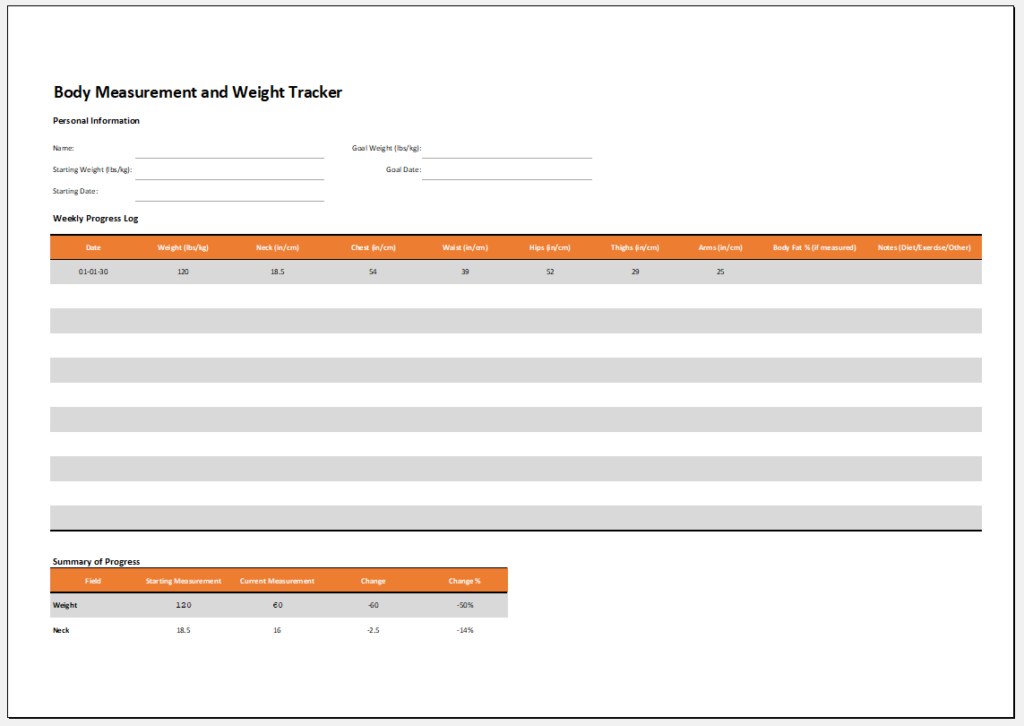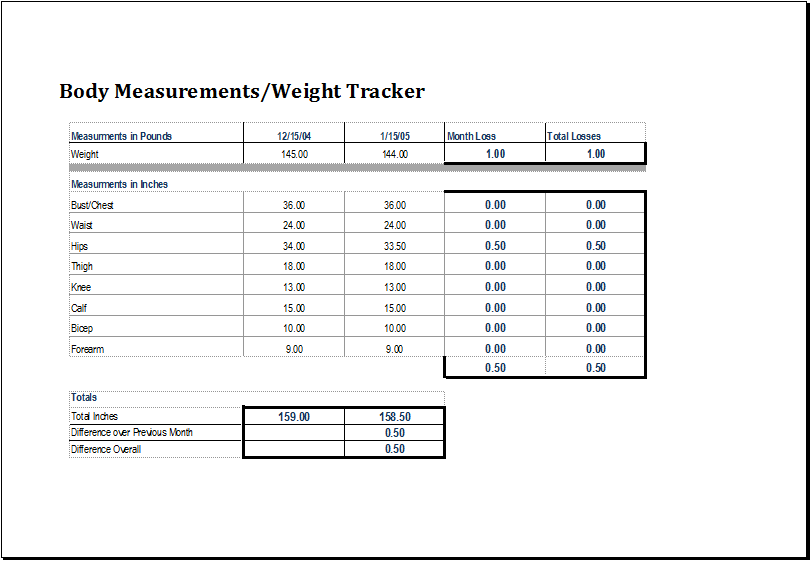Body Measurement and Weight Tracker
Many health-conscious people closely monitor their body size and weight, as tracking these measurements helps them understand changes in their health and detect weight gain early.
People who exercise and follow a diet plan to lose weight are often more focused on tracking their progress. They use a weight tracker to see if their efforts are paying off. Seeing positive results motivates them to stay committed and continue working toward their goals.
Body measurements are a useful way to track progress in both weight loss and muscle gain. Unlike a weighing scale, which only shows overall weight, body measurements reveal where fat is being lost and how your shape is changing. Even if the scale doesn’t show a big drop each week, shrinking measurements in key areas confirm that your diet and exercise plan are effective.
What is a body measurement and weight tracker?
A Body Measurement and Weight Tracker is a tool used to record and monitor changes in your body size and weight over time. It helps individuals monitor important body measurements such as the waist, hips, chest, arms, and thighs, making it easier to track progress and adjust their routines effectively.
Preview
Key Body Parts to Measure and How to Measure Them Properly:
- Neck – Wrap the measuring tape around the narrowest part of your neck.
- Waist – Measure around the slimmest part of your waist. If unclear, use the area at the level of your belly button.
- Arms – Measure around the fullest part of your upper arm.
- Chest– Measure around the fullest part of your chest, making sure the tape goes under the armpits and across the shoulder blades.
- Hips – Measure around the widest part of your hips.
- Thighs – Measure the thickest part of your thigh while standing naturally.
- Calves – Measure around the largest part of your calf muscle.
What are the benefits of using body measurement and weight tracking?
By downloading the Body Measurement and Weight Tracker, users can enjoy several key benefits:
- Accurate Body Mass and BMI Calculation:
The tracker helps calculate body mass, which is then used to determine the Body Mass Index (BMI). This indicates whether a person’s weight falls within the healthy range. - Progress Tracking Over Time:
Users can easily compare their current weight and measurements with previous records. This helps assess the effectiveness of their diet and exercise efforts. - Goal Monitoring and Time Estimation:
The tracker shows whether weight goals have been met and helps monitor overall progress. It can also estimate how long it may take to reach target goals, making planning more effective.
What should be included in the tracker?
The tracker should include the following essential details to provide a comprehensive view of a person’s physical condition:
- Height – A key factor in assessing body composition, height should be recorded in either centimeters or feet to help calculate metrics like BMI more accurately.
- Weight – Crucial for monitoring changes over time, weight should be measured in kilograms or pounds.
- Body Measurements – Specific measurements of areas such as the chest, hips, legs, feet, and shoulders provide a detailed picture of body proportions.
- Body Temperature – Recording body temperature in Celsius or Fahrenheit can help track health changes and detect irregularities.
- Body Mass Index (BMI) – Including BMI gives a quick overview of whether a person is underweight, normal weight, overweight, or obese based on height and weight.
Tips When Measuring:
Measure your body at the same time of day each time—for example, if you measured on Thursday morning last time, make sure to measure again on a Thursday morning. This helps ensure consistent and accurate results.
You can download and print a free body measurement chart from online templates to track your progress. Start by recording your initial measurements with the date, then continue measuring every two weeks and note each date. Whether the changes are big or small—positive or negative—record them accurately in the chart. Even small differences can be seen by subtracting your latest measurements from the initial ones at the bottom of the chart.
Preview
Download your file below.
- Monthly Attendance Sheet for Employees
- Student Entry & Exit Log
- Gantt Chart for Smaller Projects
- Behavior Log of Child for Schools
- Loan Repayment Tracker
- Product Sales Tracker Template
- Debit Memo Template for Excel
- Winter Attire Inventory
- Financial Projections Worksheet
- Employee Absence Tracker
- Weekly Sales Report Template
- Budget Vs Actual Statement
- Remote Work Attendance Tracker
- Mileage Expense Report Template
- Fitness Calendar Template
- Project Gantt Chart
- Daily Attendance Tracker for an Individual Employee
- Overtime Hours Tracker Template
← Previous Article
Business Planning Checklist TemplateNext Article →
Dinner Party List with Menu

Leave a Reply